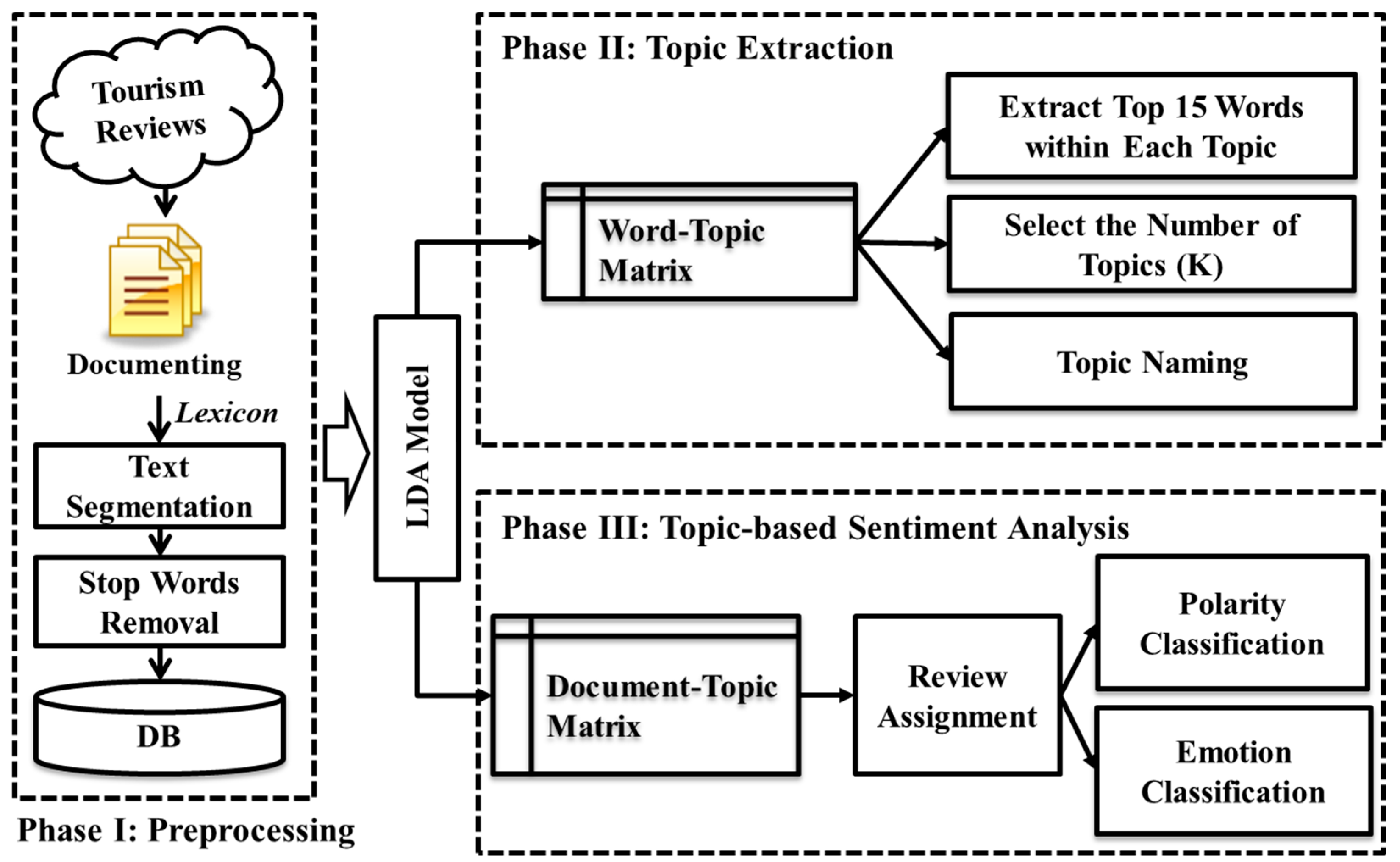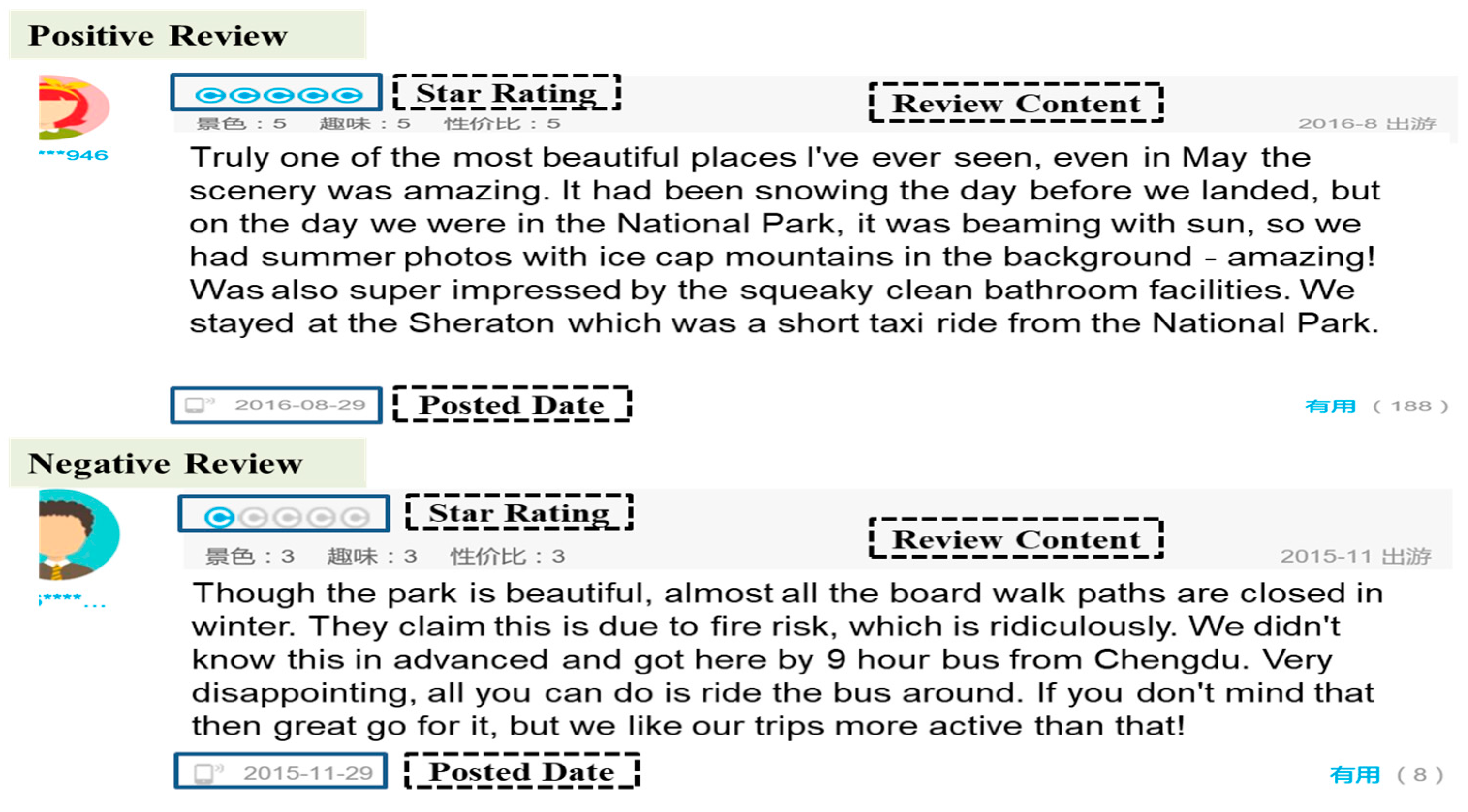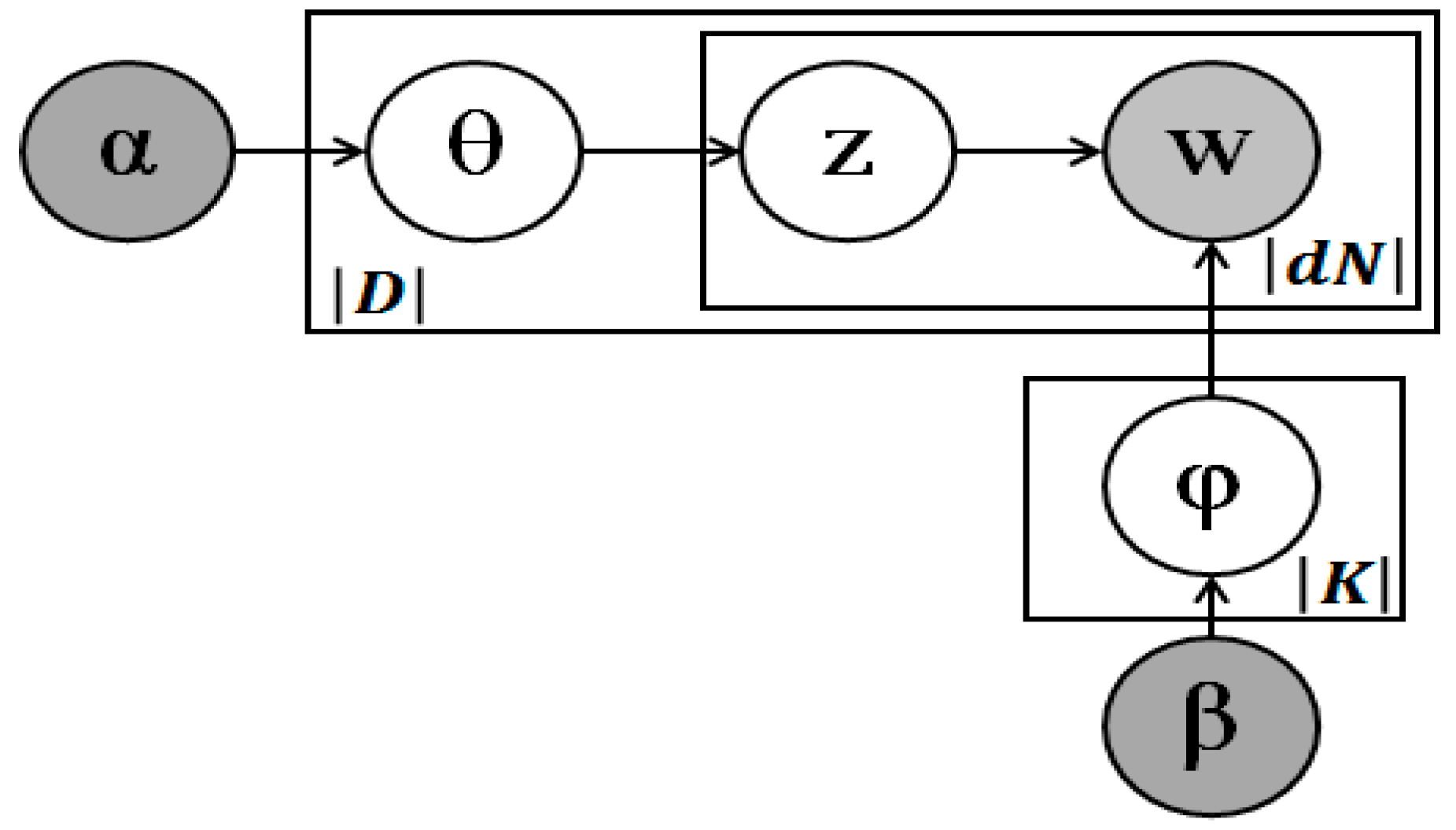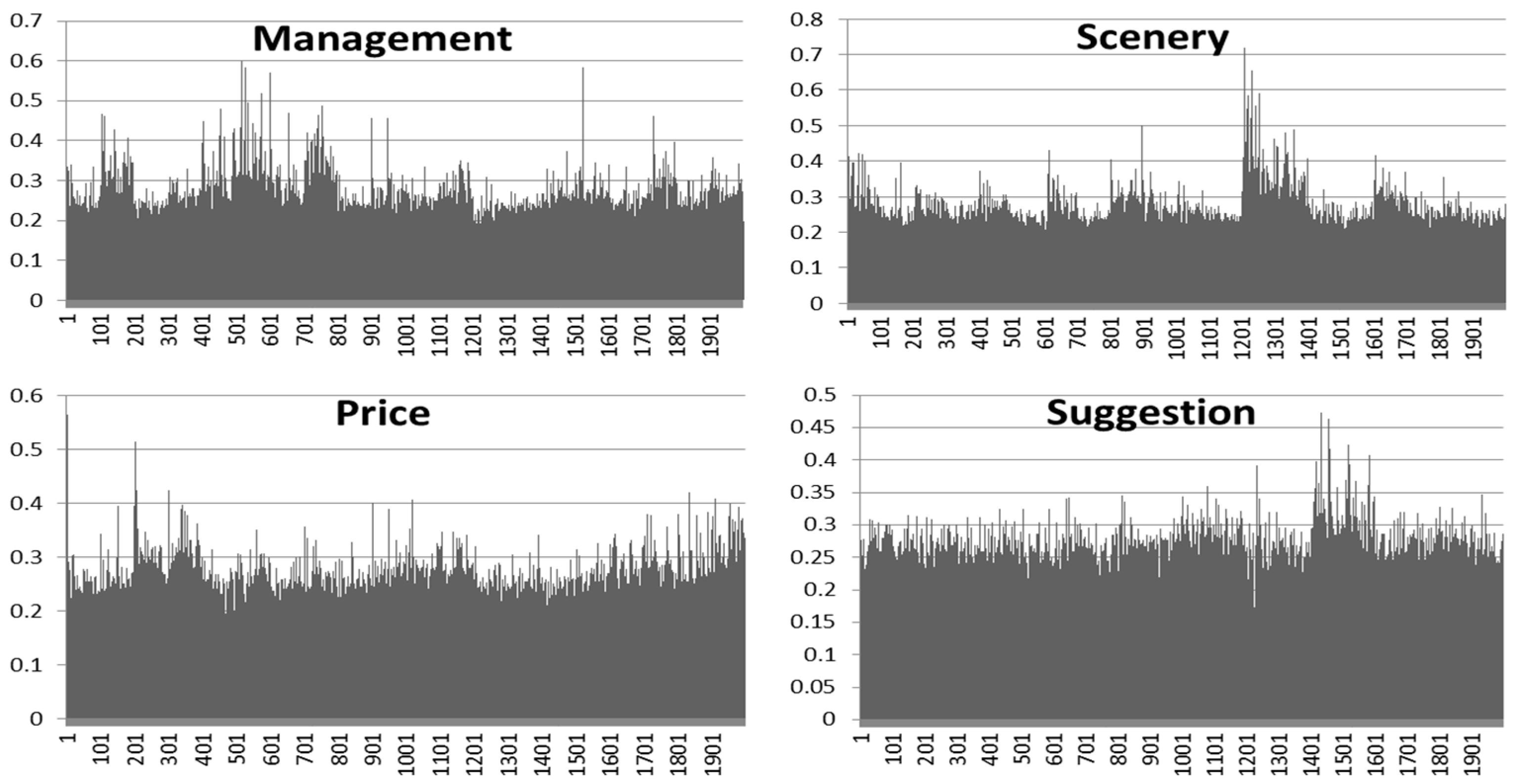Investigating Online Destination Images Using a Topic-Based Sentiment Analysis Approach
Abstract
:1. Introduction
2. Related Work
2.1. Sentiment Analysis
2.2. Studies on Tourist Reviews Using Text Mining Techniques
3. Methodology
3.1. Research Framework
3.2. Data Collection
3.3. Topic Extraction
- Choose the topic distribution
- For each word
- -
- Choose a topic
- -
- Choose a word from , a multinomial probability conditioned on topic .
3.4. Topic-Based Sentiment Analysis
4. Results
4.1. Topic Extraction
4.2. Topic-Based Sentiment Analysis
5. Discussion and Conclusions
Acknowledgments
Author Contributions
Conflicts of Interest
References
- Chevalier, J.A.; Mayzlin, D. The Effect of Word of Mouth on Sales: Online Book Reviews. J. Mark. Res. 2006, 43, 345–354. [Google Scholar] [CrossRef]
- Duan, W.; Gu, B.; Whinston, A.B. The dynamics of online word-of-mouth and product sales—An empirical investigation of the movie industry. J. Retail. 2008, 84, 233–242. [Google Scholar] [CrossRef]
- Hu, N.; Bose, I.; Gao, Y.; Liu, L. Manipulation in digital word-of-mouth: A reality check for book reviews. Decis. Support Syst. 2011, 50, 627–635. [Google Scholar] [CrossRef]
- Ye, Q.; Law, R.; Gu, B. The impact of online user reviews on hotel room sales. Int. J. Hosp. Manag. 2009, 28, 180–182. [Google Scholar] [CrossRef]
- Spool, J.M. The Magic Behind Amazon’s 2.7 Billion Dollar Question. Available online: https://articles.uie.com/magicbehindamazon/ (accessed on 5 June 2017).
- Xiang, Z.; Gretzel, U. Role of social media in online travel information search. Tour. Manag. 2010, 31, 179–188. [Google Scholar] [CrossRef]
- Sun, M.; Ryan, C.; Pan, S. Using Chinese Travel Blogs to Examine Perceived Destination Image: The Case of New Zealand. J. Travel Res. 2015, 54, 543–555. [Google Scholar] [CrossRef]
- Mak, A.H.N. Online destination image: Comparing national tourism organisation’s and tourists’ perspectives. Tour. Manag. 2017, 60, 280–297. [Google Scholar] [CrossRef]
- Crompton, J.L. An Assessment of the Image of Mexico as a Vacation Destination and the Influence of Geographical Location Upon That Image. J. Travel Res. 1979, 17, 18–23. [Google Scholar] [CrossRef]
- Lin, C.; He, Y. Joint sentiment/topic model for sentiment analysis. In Proceedings of the 18th ACM Conference on Information and Knowledge Management, Hong Kong, China, 2–6 November 2009; pp. 375–384. [Google Scholar]
- Xianghua, F.; Guo, L.; Yanyan, G.; Zhiqiang, W. Multi-aspect sentiment analysis for Chinese online social reviews based on topic modeling and HowNet lexicon. Knowl.-Based Syst. 2013, 37, 186–195. [Google Scholar] [CrossRef]
- Nguyen, T.H.; Shirai, K.; Velcin, J. Sentiment analysis on social media for stock movement prediction. Expert Syst. Appl. 2014, 42, 9603–9611. [Google Scholar] [CrossRef]
- Hu, M.; Liu, B. Mining and summarizing customer reviews. In Proceedings of the Tenth ACM SIGKDD International Conference on Knowledge Discovery and Data Mining, KDD’04, Seattle, WA, USA, 22–25 August 2004; Volume 4, p. 168. [Google Scholar]
- Marrese-Taylor, E.; Velásquez, J.D.; Bravo-Marquez, F. A novel deterministic approach for aspect-based opinion mining in tourism products reviews. Expert Syst. Appl. 2014, 41, 7764–7775. [Google Scholar] [CrossRef] [Green Version]
- Xiang, Z.; Du, Q.; Ma, Y.; Fan, W. A comparative analysis of major online review platforms: Implications for social media analytics in hospitality and tourism. Tour. Manag. 2017, 58, 51–65. [Google Scholar] [CrossRef]
- Guo, Y.; Barnes, S.J.; Jia, Q. Mining meaning from online ratings and reviews: Tourist satisfaction analysis using latent dirichlet allocation. Tour. Manag. 2017, 59, 467–483. [Google Scholar] [CrossRef]
- Pearce, P.L.; Wu, M.-Y. Entertaining International Tourists: An Empirical Study of an Iconic Site in China. J. Hosp. Tour. Res. 2015, XX, 1–21. [Google Scholar] [CrossRef]
- Liu, B. Sentiment Analysis: Mining Opinions, Sentiments, and Emotions, 1st ed.; Cambridge University Press: New York, NY, USA, 2015. [Google Scholar]
- Rozin, P.; Royzman, E.B. Negativity Bias, Negativity Dominance, and Contagion Paul. Personal. Soc. Psychol. Rev. 2001, 5, 296–320. [Google Scholar] [CrossRef]
- Baumeister, R.F.; Bratslavsky, E.; Finkenauer, C.; Vohs, K.D. Bad is stronger than good. Rev. Gen. Psychol. 2001, 5, 323–370. [Google Scholar] [CrossRef]
- Blei, D.M.; Edu, B.B.; Ng, A.Y.; Edu, A.S.; Jordan, M.I.; Edu, J.B. Latent Dirichlet Allocation. J. Mach. Learn. Res. 2003, 3, 993–1022. [Google Scholar]
- Li, N.; Wu, D. Using text mining and sentiment analysis for online forums hotspot detection and forecast. Decis. Support Syst. 2010, 48, 354–368. [Google Scholar] [CrossRef]
- Pang, B.; Lee, L.; Vaithyanathan, S. Thumbs up?: Sentiment classification using machine learning techniques. In Proceedings of the ACL-02 Conference on Empirical Methods in Natural Language Processing, Stroudsburg, PA, USA, 6–7 July 2002; pp. 79–86. [Google Scholar]
- Liu, B. Sentiment Analysis and Opinion Mining. Synth. Lect. Hum. Lang. Technol. 2012, 5, 1–167. [Google Scholar] [CrossRef]
- Moraes, R.; Valiati, J.F.; Gavião Neto, W.P. Document-level sentiment classification: An empirical comparison between SVM and ANN. Expert Syst. Appl. 2013, 40, 621–633. [Google Scholar] [CrossRef]
- Tan, S.; Zhang, J. An empirical study of sentiment analysis for chinese documents. Expert Syst. Appl. 2008, 34, 2622–2629. [Google Scholar] [CrossRef]
- Mehrabian, A.; Russell, J.A. An Approach to Environmental Psychology; MIT Press: Cambridge, CA, USA, 1974; Volume 315. [Google Scholar]
- Plutchik, R. Emotion: A Psychoevolutionary Synthesis; Harper and Row: Manhattan, NY, USA, 1980. [Google Scholar]
- Mishne, G. Experiments with mood classification in blog posts. In Proceedings of the ACM SIGIR Workshop on Stylistic Analysis of Text for Information Access, Salvador, Brazil, 15-19 August 2005; pp. 321–327. [Google Scholar]
- Yang, C.; Lin, K.; Chen, H.-H. Emotion Classification Using Web Blog Corpora. In Proceedings of the IEEE/WIC/ACM International Conference on Web Intelligence, Fremont, CA, USA, 2–5 November 2007. [Google Scholar]
- Lin, K.H.Y.; Yang, C.; Chen, H.H. Emotion classification of online news articles from the reader’s perspective. In Proceedings of the 2008 IEEE/WIC/ACM International Conference on Web Intelligence and Intelligent Agent Technology, WI-IAT’08, Sydney, Australia, 9–12 December 2008; pp. 220–226. [Google Scholar]
- Tokuhisa, R.; Matsumoto, Y. Emotion Classification Using Massive Examples Extracted from the Web. In Proceedings of the 22nd International Conference on Computational Linguistics, Manchester, UK, 18–22 August 2008; pp. 881–888. [Google Scholar]
- Chaumartin, F.-R. UPAR7: A knowledge-based system for headline sentiment tagging. In Proceedings of the 4th International Workshop on Semantic Evaluations, Prague, Czech Republic, 23–24 June 2007; pp. 422–425. [Google Scholar]
- Al Masum, S.M.; Prendinger, H.; Ishizuka, M. Emotion Sensitive News Agent: An Approach Towards User Centric Emotion Sensing from the News. In Proceedings of the IEEE/WIC/ACM International Conference on Web Intelligence, Fremont, CA, USA, 2–5 November 2007; pp. 614–620. [Google Scholar]
- Li, W.; Xu, H. Text-based emotion classification using emotion cause extraction. Expert Syst. Appl. 2014, 41, 1742–1749. [Google Scholar] [CrossRef]
- Zhang, Z.; Ye, Q.; Zhang, Z.; Li, Y. Sentiment classification of Internet restaurant reviews written in Cantonese. Expert Syst. Appl. 2011, 38, 7674–7682. [Google Scholar]
- Kang, H.; Yoo, S.J.; Han, D. Senti-lexicon and improved Naïve Bayes algorithms for sentiment analysis of restaurant reviews. Expert Syst. Appl. 2012, 39, 6000–6010. [Google Scholar] [CrossRef]
- Choi, S.; Lehto, X.Y.; Morrison, A.M. Destination image representation on the web: Content analysis of Macau travel related websites. Tour. Manag. 2007, 28, 118–129. [Google Scholar] [CrossRef]
- Levy, S.E.; Duan, W.; Boo, S. An Analysis of One-Star Online Reviews and Responses in the Washington, D.C., Lodging Market. Cornell Hosp. Q. 2013, 54, 49–63. [Google Scholar] [CrossRef]
- Ariyasriwatana, W.; Quiroga, L.M. A thousand ways to say “Delicious!” Categorizing expressions of deliciousness from restaurant reviews on the social network site Yelp. Appetite 2016, 104, 18–32. [Google Scholar] [CrossRef] [PubMed]
- Liu, Z.; Park, S. What makes a useful online review? Implication for travel product websites. Tour. Manag. 2015, 47, 140–151. [Google Scholar] [CrossRef] [Green Version]
- Bucur, C. Using Opinion Mining Techniques in Tourism. Procedia Econ. Financ. 2015, 23, 1666–1673. [Google Scholar] [CrossRef]
- Hu, Y.-H.; Chen, Y.-L.; Chou, H.-L. Opinion mining from online hotel reviews—A text summarization approach. Inf. Process. Manag. 2017, 53, 436–449. [Google Scholar] [CrossRef]
- Hu, Y.H.; Chen, K. Predicting hotel review helpfulness: The impact of review visibility, and interaction between hotel stars and review ratings. Int. J. Inf. Manag. 2016, 36, 929–944. [Google Scholar] [CrossRef]
- Farhadloo, M.; Patterson, R.A.; Rolland, E. Modeling Customer Satisfaction from Unstructured Data Using A Bayesian Approach. Decis. Support Syst. 2016, 90, 1–11. [Google Scholar] [CrossRef]
- Cenni, I.; Goethals, P. Negative hotel reviews on TripAdvisor: A cross-linguistic analysis. Discourse Context Media 2017, 16, 22–30. [Google Scholar] [CrossRef]
- Rosenberg, S.D.; Schnurr, P.P.; Oxman, T.E. Content Analysis: A Comparison of Manual and Computerized Systems. J. Personal. Assess. 1990, 54, 298–310. [Google Scholar]
- Dong, Z.; Dong, Q. HowNet—A hybrid language and knowledge resource. In Proceedings of the 2003 International Conference on Natural Language Processing and Knowledge Engineering, NLP-KE 2003, Beijing, China, 26–29 October 2003; pp. 820–824. [Google Scholar]
- Blei, D.M. Introduction to Probabilistic Topic Modeling. Commun. ACM 2012, 55, 77–84. [Google Scholar] [CrossRef]
- Maskeri, G.; Sarkar, S.; Heafield, K. Mining business topics in source code using latent dirichlet allocation. In Proceedings of the 1st India Software Engineering Conference—ISEC’08, Hyderabad, India, 19–22 February 2008; p. 113. [Google Scholar]
- Shi, Z.; Lee, G.; Whinston, A.B. Toward A Better Measure of Business Proximity: Topic Modeling for Industry Intelligence. MIS Q. 2016, 40, 1035–1056. [Google Scholar] [CrossRef]
- Alam, M.H.; Ryu, W.J.; Lee, S.K. Joint multi-grain topic sentiment: Modeling semantic aspects for online reviews. Inf. Sci. 2016, 339, 206–223. [Google Scholar] [CrossRef]
- Hindle, A.; Ernst, N.A.; Godfrey, M.W.; Mylopoulos, J. Automated Topic Naming to Support Cross-project Analysis of Software Maintenance Activities. In Proceedings of the 8th Working Conference on Mining Software Repositories, Honolulu, HI, USA, 21–22 May 2011; pp. 163–172. [Google Scholar]
- Xu, L.; Lin, H.; Pan, Y.; Ren, H.; Chen, J. Constructing the Affective Lexicon Ontology. J. China Soc. Sci. Tech. Inf. 2008, 27, 180–185. [Google Scholar]
- Liu, S.M.; Chen, J.-H. A multi-label classification based approach for sentiment classification. Expert Syst. Appl. 2015, 42, 1083–1093. [Google Scholar] [CrossRef]
- Gao, K.; Su, S.; Wang, J.S. A sentiment analysis hybrid approach for microblogging and E-commerce corpus. In Proceedings of the 2015 7th International Conference on Modelling, Identification and Control (ICMIC), Sousse, Tunisia, 18–20 December 2015; pp. 3–8. [Google Scholar]
- Beerli, A.; Martin, J.D. Factors influencing destination image. Ann. Tour. Res. 2004, 31, 657–681. [Google Scholar] [CrossRef]
- Chi, C.G.Q.; Qu, H. Examining the structural relationships of destination image, tourist satisfaction and destination loyalty: An integrated approach. Tour. Manag. 2008, 29, 624–636. [Google Scholar] [CrossRef]
- Westbrook, R.A.; Oliver, R. The Dimensionality of Consumption Emotion Pattems and Consumer Satisfaction. J. Consum. Res. 1991, 18, 84–91. [Google Scholar] [CrossRef]
- Jin, Q.; Liu, N.N.; Bay, C.W.; Kong, H.; Zhao, K. Transferring Topical Knowledge from Auxiliary Long Texts for Short Text Clustering. In Proceedings of the 20th ACM International Conference on Information and Knowledge Management, Scotland, UK, 24–28 October 2011; pp. 775–784. [Google Scholar]







| Type | Concept | Study | Data 1 | Method 2 |
|---|---|---|---|---|
| Content analysis | Refers to the process that quantifies or qualifies the unstructured text data. | Choi et al. (2007) [38] | 81 sites | Identifies the words frequently used in each of five sub-categories of websites. |
| Levy et al. (2013) [39] | T | Extracts hotel complaints using one-star reviews | ||
| Ariyasriwatana and Quiroga (2016) [40] | Y | Explores expressions of deliciousness | ||
| Liu and Park (2015) [41] | Y | Examines the effect of review content features on helpfulness | ||
| Document-based sentiment analysis | Refers to the process that analyzes sentiments or emotions at the document level. | Zhang et al. (2011) [36] | - | Performs a polarity classification using SVM and NB |
| Kang et al. (2012) [37] | - | Proposes a polarity classification approach based on senti-lexicon and NB | ||
| Hu et al. (2017) [43] | T | Identifies the most informative sentences using a multi-text summarization technique | ||
| Bucur (2015) [42] | T | Performs polarity classifications based on a lexicon | ||
| Hu and Chen (2016) [44] | T | Uses review sentiment features to predict helpfulness. | ||
| Topic-based sentiment analysis | Refers to the process of topic extraction and analyzing sentiments and emotions at the topic level | Pearce and Wu (2015) [17] | T | Extracts tourism topics of attraction by a thematic and semantic analysis |
| Marrese-Taylor et al. (2014) [14] | T | Proposes a deterministic rule for word and sentiment orientation | ||
| Farhadloo et al. (2016) [45] | T | Extracts topics using a Bayesian approach | ||
| Xiang et al. (2017) [15] | T, E, Y | Extracts topics on three platforms using an LDA model | ||
| Cenni and Goethals (2017) [46] | T | Examines the divergence over topics written in different languages using a Cross-linguistic analysis approach | ||
| Guo et al. (2017) [16] | T | Extracts hotel topics using an LDA model |
| Reviews | Number of Reviews | Mean | Maximum | Minimum |
|---|---|---|---|---|
| Positive reviews | 1000 | 87 | 1055 | 6 |
| Negative reviews | 1000 | 85 | 687 | 15 |
| Total reviews | 2000 | 86 | 1055 | 6 |
| Topic Naming Method | Study |
|---|---|
| Topics are named manually by summarizing the meaning of frequent words or assigning a topic from the predefined topics | Maskeri et al. (2008) [50]; Xianghua et al. (2013) [11]; Shi et al. (2016) [51]; Alam et al. (2016) [52]; Xiang et al. (2017) [15]; Guo et al. (2017) [16] |
| Topics are named automatically based on supervised learning and a user-defined word-list | Hindle et al. (2011) [53] |
| Top 15 Words and Corresponding Weights 1 | |||||
|---|---|---|---|---|---|
| Topic 1. Management 0.2177 | |||||
| attraction | 0.0445 | time | 0.0212 | suggest | 0.0190 |
| hour | 0.0174 | tourist | 0.0153 | hotel | 0.0120 |
| queue | 0.0115 | guide | 0.0114 | cableway | 0.0114 |
| service | 0.0106 | cable car | 0.0101 | visit | 0.0095 |
| charged | 0.0081 | beauty | 0.0078 | management | 0.0077 |
| Topic 2. Scenery 0.1688 | |||||
| landscape | 0.0321 | worth | 0.0296 | rape flower | 0.0136 |
| beautiful | 0.0129 | season | 0.0108 | park | 0.0084 |
| all the way | 0.0079 | best | 0.0077 | esthetical | 0.0074 |
| rental car | 0.0073 | lakeside | 0.0065 | feel | 0.0065 |
| sunrise | 0.0063 | photograph | 0.0061 | cattle | 0.0057 |
| Topic 3. Price and Scenery 0.2873 | |||||
| local | 0.0415 | scenery | 0.0412 | good | 0.0348 |
| ticket | 0.0333 | feel | 0.0280 | special | 0.0167 |
| night | 0.0105 | just so so | 0.0132 | very beautiful | 0.0134 |
| like | 0.0105 | cost-effective | 0.0094 | commercialized | 0.0092 |
| really | 0.0088 | bad | 0.0085 | a visit | 0.0081 |
| Top 15 Words and Corresponding Weights 1 | ||||||
|---|---|---|---|---|---|---|
| Topic 1. Management 0.2823 | ||||||
| attraction | 0.0583 | ticket | 0.0416 | hour | 0.0228 | |
| tourist | 0.0201 | just so so | 0.0162 | hotel | 0.0157 | |
| queue | 0.0151 | cableway | 0.0150 | service | 0.0139 | |
| cable car | 0.0133 | really | 0.0110 | bad | 0.0106 | |
| management | 0.0101 | top of mountain | 0.0098 | only | 0.0088 | |
| Topic 2. Scenery 0.1345 | ||||||
| beautiful | 0.0169 | season | 0.0137 | beauty | 0.0109 | |
| best | 0.0105 | all the way | 0.0103 | esthetical | 0.0097 | |
| feel | 0.0085 | sightseeing | 0.0079 | cattle | 0.0074 | |
| clouds | 0.0069 | experience | 0.0068 | back | 0.0066 | |
| lake | 0.0063 | km | 0.0061 | blue sky | 0.0061 | |
| Topic 3. Price 0.2412 | ||||||
| local | 0.0548 | feel | 0.0371 | guide | 0.0158 | |
| night | 0.0139 | like | 0.0139 | visit | 0.0131 | |
| recommend | 0.0126 | commercialized | 0.0121 | charged | 0.0112 | |
| park | 0.0109 | disappointed | 0.0102 | feature | 0.0097 | |
| weather | 0.0089 | cheap | 0.0088 | lodge | 0.0081 | |
| Topic 4. Suggestion 0.3818 | ||||||
| scenery | 0.0568 | good | 0.0480 | worth | 0.0443 | |
| landscape | 0.0435 | time | 0.0307 | suggest | 0.0275 | |
| special | 0.0230 | beautiful | 0.0185 | rape flower | 0.0185 | |
| friends | 0.0138 | cost-effective | 0.0130 | price | 0.0128 | |
| a visit | 0.0112 | be fit for | 0.0102 | choose | 0.0100 | |
| Top 15 Words and Corresponding Weights 1 | |||||
|---|---|---|---|---|---|
| Topic 1. Management 0.2781 | |||||
| time | 0.0353 | suggest | 0.0316 | ticket | 0.0303 |
| hour | 0.0290 | hotel | 0.0200 | queue | 0.0192 |
| cableway | 0.0190 | friends | 0.0165 | cable car | 0.0130 |
| top of mountain | 0.0125 | schedule | 0.0107 | downhill | 0.0107 |
| several | 0.0104 | mood | 0.0102 | sunrise | 0.0098 |
| Topic 2. Scenery 0.1673 | |||||
| beautiful | 0.0210 | season | 0.0353 | beauty | 0.0136 |
| all the way | 0.0128 | best | 0.0126 | rental car | 0.0118 |
| lakeside | 0.0106 | feel | 0.0106 | cattle | 0.0092 |
| clouds | 0.0086 | experience | 0.0084 | on the way | 0.0082 |
| natives | 0.0078 | lake | 0.0078 | km | 0.0076 |
| Topic 3. Price and Management 0.2709 | |||||
| attraction | 0.0747 | tourist | 0.0257 | ticket | 0.0226 |
| guide | 0.0192 | service | 0.0178 | visit | 0.0159 |
| bad | 0.0135 | charged | 0.0135 | management | 0.0122 |
| only | 0.0112 | two | 0.0106 | dine | 0.0087 |
| drive | 0.0085 | staff | 0.0083 | too bad | 0.0083 |
| Topic 4. Suggestion 0.3265 | |||||
| good | 0.0587 | feel | 0.0473 | special | 0.0281 |
| rape flower | 0.0226 | just so so | 0.0220 | night | 0.0177 |
| cost- effective | 0.0159 | recommend | 0.0161 | like | 0.0177 |
| commercialized | 0.0155 | really | 0.0149 | price | 0.0126 |
| be fit for | 0.0124 | feature | 0.0124 | choose | 0.0122 |
| Topic 5. Scenery 0.3921 | |||||
| local | 0.0713 | scenery | 0.0709 | worth | 0.0553 |
| landscape | 0.0542 | very beautiful | 0.0231 | park | 0.0141 |
| a visit | 0.0139 | disappointed | 0.0133 | esthetical | 0.0125 |
| beautiful | 0.0123 | weather | 0.0116 | photograph | 0.0104 |
| sightseeing | 0.0102 | been | 0.0100 | pity | 0.0091 |
| Topic Number K | 3 | 4 | 5 |
|---|---|---|---|
| Average KL distance between topics | 7.6899 | 7.7199 | 7.2895 |
| Topic | Extracted Words | Distinctive Words | Topic Naming |
|---|---|---|---|
| Topic 1 | attraction, ticket, hour, tourist, just so so, hotel, queue, cableway, service, cable car, really, bad, management, top of mountain, only | queue, cableway, hour, service, cable car, management | management |
© 2017 by the authors. Licensee MDPI, Basel, Switzerland. This article is an open access article distributed under the terms and conditions of the Creative Commons Attribution (CC BY) license (http://creativecommons.org/licenses/by/4.0/).
Share and Cite
Ren, G.; Hong, T. Investigating Online Destination Images Using a Topic-Based Sentiment Analysis Approach. Sustainability 2017, 9, 1765. https://doi.org/10.3390/su9101765
Ren G, Hong T. Investigating Online Destination Images Using a Topic-Based Sentiment Analysis Approach. Sustainability. 2017; 9(10):1765. https://doi.org/10.3390/su9101765
Chicago/Turabian StyleRen, Gang, and Taeho Hong. 2017. "Investigating Online Destination Images Using a Topic-Based Sentiment Analysis Approach" Sustainability 9, no. 10: 1765. https://doi.org/10.3390/su9101765




